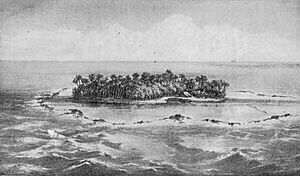Nukapu Expedition facts for kids
Quick facts for kids Nukapu Expedition |
|||||||
|---|---|---|---|---|---|---|---|
 Nukapu c. 1870 |
|||||||
|
|||||||
| Belligerents | |||||||
| Nukapu natives | |||||||
| Commanders and leaders | |||||||
| Albert Hastings Markham | Unknown | ||||||
| Casualties and losses | |||||||
| 1 killed, 2 wounded | 20–30 killed | ||||||
The Nukapu expedition was a journey by the British Navy between October 1871 and February 1872. It was a "punitive expedition," which means it was a military action taken to punish someone. This expedition happened because a missionary named John Coleridge Patteson was killed by people from Nukapu. Nukapu is one of the eastern islands in the Solomon Islands, located in the South Pacific Ocean.
During the expedition, a Royal Navy warship was sent to Nukapu. The ship attacked and sank several war-canoes belonging to the islanders. British sailors also landed on the island to attack a fortified village.
The Expedition Begins
In October 1871, a British warship called HMS Rosario was sailing near the South Sea Islands. This ship was usually working to stop "blackbirders." Blackbirders were people who illegally kidnapped islanders to force them to work.
The captain of the Rosario was Commander Albert Hastings Markham. He received new orders to sail to Nukapu in the Solomon Islands. The goal was to respond to the killing of missionary John Coleridge Patteson.
Actions and Discussions
The actions taken by the Rosario became a topic of discussion back in Britain. People in the House of Commons, which is like the British parliament, asked questions about what happened.
Commander Markham later wrote a book about his experiences. In his book, he showed that he understood the cycle of violence happening in the islands. He did not like the actions of the blackbirders, who caused many problems. He also understood why the Navy felt it needed to use force to bring order back.

